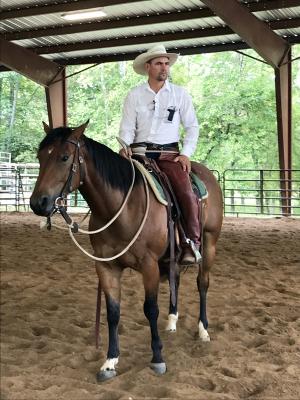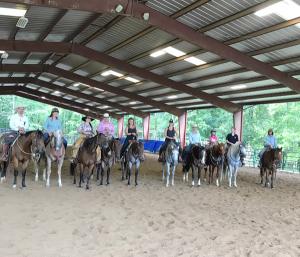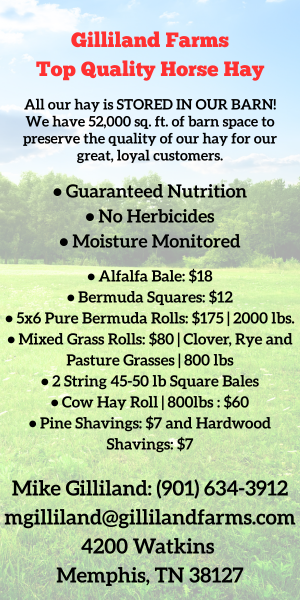By Lisa Sparks
On September 8-9, 2018 I audited a Ricky Quinn basic horsemanship clinic, hosted by Nashville-area riding teacher Alicia Landman. Alicia annually hosts Ricky’s clinics at the Hurricane Creek Ranch in Lebanon, Tennessee. Alicia, her students, and other interested riders participated in this three day event to improve their riding skills. To explain his horsemanship goals, Quinn began with a quote from Ray Hunt: “My goal with the horse is not to beat someone; it is to win – within myself to do the best job I can do and tomorrow to try to do better. You’ll be working on yourself to accomplish this, not your horse.”
Ricky grew up in Ten Sleep, Wyoming and has devoted himself to the Buck Brannaman horsemanship method since the age of 17, when he first met Buck. He now lives in Nebraska with his family, working a cattle operation. A gifted and accomplished clinician, he spreads the word about the gentle approach to horses and participates in the Legacy of Legends to teach horsemanship to the next generation. This year he worked with Buck Bannaman’s Master Colt Starting group to start a colt in the tradition of Ray Hunt and Tom Dorrance. Ricky said that he likes helping people learn about horses.
Hurricane Creek is privately owned, tucked away in gently rolling hills off a winding country road, just up from the General Store where lunch was served. This quaint, picturesque setting was the backdrop for Ricky Quinn’s community of riders. This review covers the last two days, starting with how the students had progressed with cantering the horse on a lead line to riding their horse balanced in the canter. The goal was to increase their awareness of body movements and balance.
The morning groundwork focused on shifting the horse’s weight to the hindquarters without the horse bracing its head upward. Assisting the horse to get the correct timing of his feet and to allow him to balance requires feel from the handler through the lead rope. Using the fence as a place to cue for the trot, the horse was able to get his hind feet underneath himself. The goal was to get a smooth, balanced transition into the canter.
Some horses pulled back when they became unbalanced and some rushed forward. Quinn coached the participants on how to read the horse’s body language so their cues would be effective. Knowing when to put pressure on the horse and when to release pressure is vital. “His feet must stay under him to carry the load,” Quinn reminded them, as each participant worked toward a continual lope in a large circle. A smaller circle makes it difficult for horses to find their balance. Once the horse was able to get his feet under himself, balancing with a lower head position was possible, a position which indicated a relaxed mental condition. Patience from the handler proved essential, and any additional pressure from the handler, determined for this to happen quicker, caused the horse to brace his body, raise his head, hollow the back, and feet not move.
“You must build your way into the center; don’t just demand that the horse do it, especially when he is not ready,” Quinn emphasized. “They are willing, but they need your support as they find their way.” Quinn knew how to support the riders so they, in turn, could support the horse. Quinn’s sensitivity showed as he skillfully instructed each rider how to become a supportive leader for their horse on the ground first.
Alicia’s seven year old daughter, Riv, participated in the clinic, and Quinn observed how she was more concerned about her horse not getting the left lead, while the adults were still having issues with getting the horse to respond and go straight. “Children and horses think about eating and playing, while adults are concerned with results,” Quinn pointed out. “There are times when horses need a boundary and there are times when you need to allow them to have their freedom. If the expression is good, the horse is trying. So give them release and build on watching them find it. Many times the human’s strong desire to achieve is something the horse cannot process. A child offers empathy, and the determined ego of an adult communicates frustration and fear.”
Quinn addressed the problem of getting the horse’s attention and keeping it. He referred to this as the horse “looking you up.” To illustrate this, Quinn shared a story about his young son. During a busy time doing mechanical repairs on the tractor, his young son Keegan was riding around in his battery powered car, focused in his world of play. Suddenly he purposefully drove up to his dad and introduced himself as Keegan, the man from NAPA, and said “I have parts for you.” If you are interesting, the horse will “look you up,” Quinn said. The momentary response when a horse faces you with both eyes signals the willingness of the horse to work.
The afternoon session began by using a young, sensitive, troubled horse to demonstrate what to do when the horse becomes resistant. The bracing that the horse presents in moments of fear can be addressed with good techniques learned from groundwork and basic riding preparation. A tarp was hung on one panel of the arena to provide a distraction. Quinn rode in a big circle toward and away from the tarp. Patiently, he assisted the horse as she found her way through the walk, trot, canter, stop and back. Many times she resisted, so to keep her mind on him, Quinn used the serpentine movement to allow the horse to refocus. By keeping her feet moving in a balanced way, the horse was able to think. Many times the troubles that our horses display by refusing to go forward, wanting to squirt forward, or choosing to whirl away from the scary object, leads us to be more physical.
During the riding time, Quinn worked on improving the one rein stop, the stop, spiraling down, and introducing the stop without hands. These movements were carefully broken down and many of the riders visibly improved. But it was his patience with the riders’ understanding the canter that was the most impressive. Emphasis on the rider’s correct leg position and bringing the leading rein out gave the horse a place to go. Everyone cantered to their best ability as Quinn coached from his horse.
Quinn’s groundwork exercises demonstrated understanding the canter from the horse’s perspective. He observed that most people who have trouble cantering their horse only see it from the human perspective. The people in the clinic improved at the canter because Quinn gave them a clearer understanding of the canter from the horse’s point of view. To be a leader for the horse, the rider has to understand what the horse needs to support himself. When the rider becomes a leader, the horse begins to think his way through it.
During a lunch break I spoke with Quinn about clinics. He remembered when people flocked to Buck’s clinics to learn what Ray and Tom had to pass on, but now the clinic world is very diverse, with many clinicians offering gimmicks and short cuts to try to achieve what really requires time for the horse to process. For riders to grow in their horsemanship knowledge, he recommended they should join a group that adheres to the true standards.
Alicia Landman has followed Buck’s teachings and has started colts at his ranch in Sheridan, Wyoming. (Visit Alicia Byberg-Landman Horsemanship on Facebook.) To have a lasting effect, Quinn believes that the host or hostess of the clinic is fundamental to the work of the clinician. So in Alicia’s lessons, her students practice what they have learned at his clinics.
Auditing clinic gave me a clear understanding of how the work of Tom and Ray affects local horse communities across the nation. Quinn is one of the 32 participants at the Legacy of Legends (alegacyoflegends.com) that continues preserving their traditions. As the masters like Buck grow older, they pass on these timeless truths through instructors like Quinn. Always seek the better ride, and your horse will be your “man from NAPA who has parts for you.”
On September 8-9, 2018 I audited a Ricky Quinn basic horsemanship clinic, hosted by Nashville-area riding teacher Alicia Landman. Alicia annually hosts Ricky’s clinics at the Hurricane Creek Ranch in Lebanon, Tennessee. Alicia, her students, and other interested riders participated in this three day event to improve their riding skills. To explain his horsemanship goals, Quinn began with a quote from Ray Hunt: “My goal with the horse is not to beat someone; it is to win – within myself to do the best job I can do and tomorrow to try to do better. You’ll be working on yourself to accomplish this, not your horse.”
Ricky grew up in Ten Sleep, Wyoming and has devoted himself to the Buck Brannaman horsemanship method since the age of 17, when he first met Buck. He now lives in Nebraska with his family, working a cattle operation. A gifted and accomplished clinician, he spreads the word about the gentle approach to horses and participates in the Legacy of Legends to teach horsemanship to the next generation. This year he worked with Buck Bannaman’s Master Colt Starting group to start a colt in the tradition of Ray Hunt and Tom Dorrance. Ricky said that he likes helping people learn about horses.
Hurricane Creek is privately owned, tucked away in gently rolling hills off a winding country road, just up from the General Store where lunch was served. This quaint, picturesque setting was the backdrop for Ricky Quinn’s community of riders. This review covers the last two days, starting with how the students had progressed with cantering the horse on a lead line to riding their horse balanced in the canter. The goal was to increase their awareness of body movements and balance.
The morning groundwork focused on shifting the horse’s weight to the hindquarters without the horse bracing its head upward. Assisting the horse to get the correct timing of his feet and to allow him to balance requires feel from the handler through the lead rope. Using the fence as a place to cue for the trot, the horse was able to get his hind feet underneath himself. The goal was to get a smooth, balanced transition into the canter.
Some horses pulled back when they became unbalanced and some rushed forward. Quinn coached the participants on how to read the horse’s body language so their cues would be effective. Knowing when to put pressure on the horse and when to release pressure is vital. “His feet must stay under him to carry the load,” Quinn reminded them, as each participant worked toward a continual lope in a large circle. A smaller circle makes it difficult for horses to find their balance. Once the horse was able to get his feet under himself, balancing with a lower head position was possible, a position which indicated a relaxed mental condition. Patience from the handler proved essential, and any additional pressure from the handler, determined for this to happen quicker, caused the horse to brace his body, raise his head, hollow the back, and feet not move.
“You must build your way into the center; don’t just demand that the horse do it, especially when he is not ready,” Quinn emphasized. “They are willing, but they need your support as they find their way.” Quinn knew how to support the riders so they, in turn, could support the horse. Quinn’s sensitivity showed as he skillfully instructed each rider how to become a supportive leader for their horse on the ground first.
Alicia’s seven year old daughter, Riv, participated in the clinic, and Quinn observed how she was more concerned about her horse not getting the left lead, while the adults were still having issues with getting the horse to respond and go straight. “Children and horses think about eating and playing, while adults are concerned with results,” Quinn pointed out. “There are times when horses need a boundary and there are times when you need to allow them to have their freedom. If the expression is good, the horse is trying. So give them release and build on watching them find it. Many times the human’s strong desire to achieve is something the horse cannot process. A child offers empathy, and the determined ego of an adult communicates frustration and fear.”
Quinn addressed the problem of getting the horse’s attention and keeping it. He referred to this as the horse “looking you up.” To illustrate this, Quinn shared a story about his young son. During a busy time doing mechanical repairs on the tractor, his young son Keegan was riding around in his battery powered car, focused in his world of play. Suddenly he purposefully drove up to his dad and introduced himself as Keegan, the man from NAPA, and said “I have parts for you.” If you are interesting, the horse will “look you up,” Quinn said. The momentary response when a horse faces you with both eyes signals the willingness of the horse to work.
The afternoon session began by using a young, sensitive, troubled horse to demonstrate what to do when the horse becomes resistant. The bracing that the horse presents in moments of fear can be addressed with good techniques learned from groundwork and basic riding preparation. A tarp was hung on one panel of the arena to provide a distraction. Quinn rode in a big circle toward and away from the tarp. Patiently, he assisted the horse as she found her way through the walk, trot, canter, stop and back. Many times she resisted, so to keep her mind on him, Quinn used the serpentine movement to allow the horse to refocus. By keeping her feet moving in a balanced way, the horse was able to think. Many times the troubles that our horses display by refusing to go forward, wanting to squirt forward, or choosing to whirl away from the scary object, leads us to be more physical.
During the riding time, Quinn worked on improving the one rein stop, the stop, spiraling down, and introducing the stop without hands. These movements were carefully broken down and many of the riders visibly improved. But it was his patience with the riders’ understanding the canter that was the most impressive. Emphasis on the rider’s correct leg position and bringing the leading rein out gave the horse a place to go. Everyone cantered to their best ability as Quinn coached from his horse.
Quinn’s groundwork exercises demonstrated understanding the canter from the horse’s perspective. He observed that most people who have trouble cantering their horse only see it from the human perspective. The people in the clinic improved at the canter because Quinn gave them a clearer understanding of the canter from the horse’s point of view. To be a leader for the horse, the rider has to understand what the horse needs to support himself. When the rider becomes a leader, the horse begins to think his way through it.
During a lunch break I spoke with Quinn about clinics. He remembered when people flocked to Buck’s clinics to learn what Ray and Tom had to pass on, but now the clinic world is very diverse, with many clinicians offering gimmicks and short cuts to try to achieve what really requires time for the horse to process. For riders to grow in their horsemanship knowledge, he recommended they should join a group that adheres to the true standards.
Alicia Landman has followed Buck’s teachings and has started colts at his ranch in Sheridan, Wyoming. (Visit Alicia Byberg-Landman Horsemanship on Facebook.) To have a lasting effect, Quinn believes that the host or hostess of the clinic is fundamental to the work of the clinician. So in Alicia’s lessons, her students practice what they have learned at his clinics.
Auditing clinic gave me a clear understanding of how the work of Tom and Ray affects local horse communities across the nation. Quinn is one of the 32 participants at the Legacy of Legends (alegacyoflegends.com) that continues preserving their traditions. As the masters like Buck grow older, they pass on these timeless truths through instructors like Quinn. Always seek the better ride, and your horse will be your “man from NAPA who has parts for you.”










